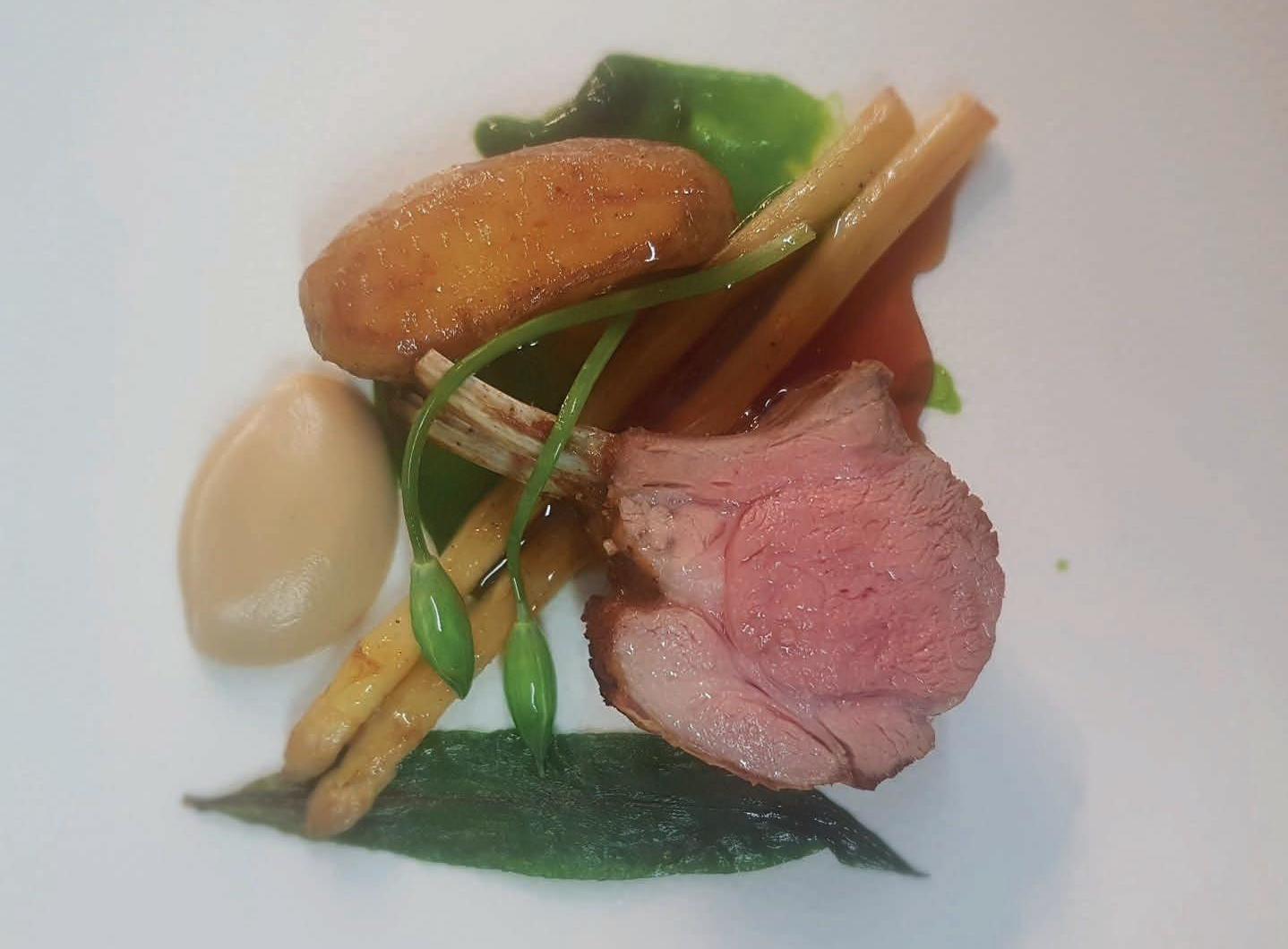
4 minute read
Dine & Wine - Chris Rees
Chris Rees, Head Chef at the River Room Restaurant at Galgorm Spa & Golf Resort, serves rack of lamb with Jersey Royal potatoes, white asparagus, cauliflower and wild garlic.
Dine & Wine
Serves two

This is a staple spring dish from The River Room menu. It uses local spring lamb, new season Jersey Royal potatoes and wild garlic from the grounds of the resort. Also being English asparagus season, it is complemented nicely by a couple of spears of white asparagus. It has a nice rich and smooth cauliflower puree to add a bit of extra substance to the dish and another texture.
For the cauliflower puree:
• Trim the florets off the cauliflower and discard the stalks and leaves. • Cover with a little milk and a small knob of butter and simmer in a saucepan until the cauliflower is soft. Add around 50g of parmesan and blend until smooth, then set aside.
For the Jersey Royal potatoes:
• Wash the potatoes until very clean then trim off a little lengthways on each side to form a flat surface. • Take a wide saucepan and coat the bottom with a little butter (around 75g). • Season the butter well then push the potatoes into it, cook on a stove on a low to medium heat until they are golden on one side, being careful not to burn the butter. The potatoes can go into a low oven at this point if they are still not cooked.
For the white asparagus:
• Carefully peel a couple of spears of white asparagus. English is best this time of year, green asparagus will do, too. Rinse well with cold water then gently poach in salted boiling water. Checking with a small, pointed knife, ensure they are just soft. Remove from the water and set aside. • The asparagus can be gently rolled through the pan with the lamb racks until slightly golden, just prior to serving.
For the wild garlic:
• Gather a few leaves and a few flowers of wild garlic from any known spots, or alternatively buy from a good vegetable shop. Spring cabbage will work as well. Brush the leaves of garlic with a little oil and season. Add the flowers and stems to the water with the white asparagus for around 30 seconds until slightly wilted then set aside.
For the lamb:
• Obtain a large 7-8 bone French trimmed lamb rack from a butcher. • Season well and place in a hot pan with oil, and colour until dark brown but not burnt. The best way to cook the lamb is to place it in a low oven wrapped in foil at around 120°C. Remove the lamb from the oven when the core temperature is at 52°C – this should take around 40 to 50 minutes – and allow to rest. (Use a temperature probe to test the core temperature.)
To assemble the dish:
• First cook the lamb, then the potatoes: they can go in the oven together. • Next make the cauliflower puree and keep warm. • While the lamb and potatoes are in the oven, cook the asparagus in the water along with the garlic stems and flowers. Add these to the pan the lamb was cooked in for a minute or so and gently colour in the lamb fat. • Remove the vegetables and add a little lamb stock to the pan to collect the juices, then reduce to create a light sauce. Finish with a splash of madeira or red wine. • Add the garlic leaves to the oven on a tray for a few minutes and allow them to crisp up. • Once the lamb has rested, carve off a few cutlets and place on a plate. • Add the vegetables and Jersey Royals and finish with a spoonful of the cauliflower puree, a couple of crispy garlic leaves and the sauce.
Need the perfect pairing?
Drinking good wine with good food is one of life’s great pleasures. The River Room Restaurant’s resident wine expert, Andrea Mola, recommends the perfect wine to accompany Head Chef Chris Rees’ delicious starter.
Wine Pairing: Zolla Primitivo di Manduria
The vineyards are mostly situated in the communes of Manduria and Sava and are owned by growers with whom Filippo has been working for many years.
Production is lower than its potential, which ensures the best quality grapes are selected. The red soils are calcareous clay and rich in iron, minerals, and nutrients. Eighty per cent of the grapes come from old bush vines and the rest from trained vines that are at least 20 years old. The grapes were gently pressed and cooled to 10°C for a maceration period of 10 to 12 days with regular pumping over. Yeasts were added to start fermentation, which took place under temperature-controlled conditions of up to 20°C. The wine was then transferred to second and third passage oak barriques for six to eight months before bottling.
Ruby red colour with violet tones. Intense and complex perfumes of red cherries and blackberries, with some spice and leather which follow on to the palate. This wine has a rich and velvety texture, generous tannins and great length.










